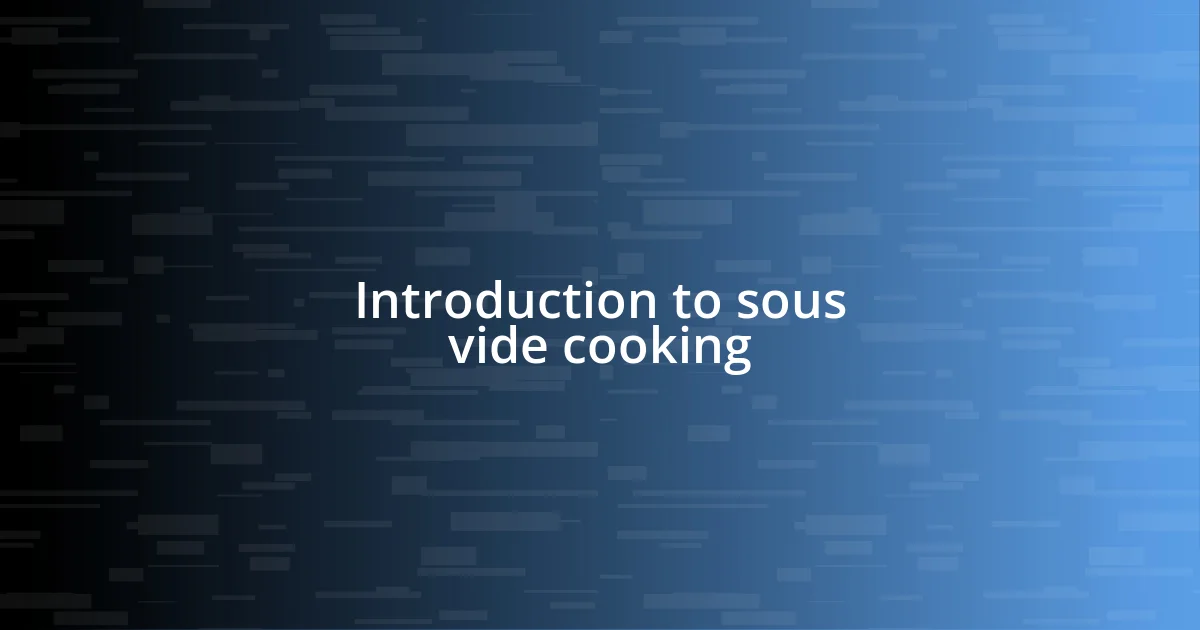Key takeaways:
- Sous vide cooking enhances precision and consistency, transforming ordinary meals into extraordinary dining experiences.
- Choosing the right equipment and high-quality, fresh ingredients is essential for achieving optimal sous vide results.
- Understanding key techniques, such as cooking times, temperature control, and troubleshooting issues, is crucial for mastering sous vide cooking.

Introduction to sous vide cooking
Sous vide cooking, which translates to “under vacuum” in French, captivates me with its simplicity and precision. Imagine immersing food in a temperature-controlled water bath for hours; it’s like magic. The first time I tried this method, I was astounded by how a humble steak transformed into a tender, flavorful masterpiece.
I remember sitting down to enjoy that steak, and it felt like a special occasion, despite it being an ordinary Tuesday. The beauty of sous vide is that it empowers me to achieve consistent results, which is especially comforting when entertaining friends. Have you ever been nervous about cooking for guests? Sous vide eliminates that anxiety—each bite is a delightful reminder of how meticulous cooking can elevate any meal.
What’s fascinating about sous vide is how it encourages exploration in the kitchen. It invites you to experiment with flavors and ingredients in ways that traditional methods might limit. I often wonder if this technique has been around for so long, why it took us so long to fully embrace it. The potential for creativity and the satisfaction of perfectly cooked food make it an exciting journey every time I decide to sous vide.

Understanding sous vide equipment
Understanding the right sous vide equipment is essential for achieving the perfect results. At a minimum, you’ll need a sous vide immersion circulator, which maintains water at a precise temperature, and vacuum-sealed bags or containers to hold your food. I vividly recall my first experience with a budget circulator; while it did the job, upgrading to a higher-end model was a game changer for my confidence in cooking.
Choosing the right vessel also plays a crucial role. Stainless steel pots are durable and easy to clean, but I find that using a dedicated sous vide container with a lid helps maintain temperature more efficiently, especially during long cook times. One evening, I managed to cook a beef brisket for 36 hours, and it emerged fork-tender—an experience I wouldn’t trade for anything. The right equipment truly amplifies the magic of sous vide.
To help you navigate the options, here’s a comparison of common sous vide equipment:
| Equipment | Key Features |
|---|---|
| Immersion Circulator | Temperature control, water circulation, portability |
| Sous Vide Container | Temperature retention, space-efficient, often includes a lid |
| Vacuum Sealer | Removes air, prevents freezer burn, enhances flavor infusion |

Selecting the right ingredients
Selecting the right ingredients for sous vide is crucial because this cooking method truly highlights the natural flavors of food. I’ve learned that freshness makes a remarkable difference. For instance, I once decided to sous vide some vegetables. The contrast between using fresh, seasonal produce and store-bought items was astounding. The fresh vegetables melded beautifully with the seasonings, creating a vibrant dish that spoke to the essence of each ingredient.
When it comes to proteins, quality is non-negotiable. I can’t stress enough how sourcing grass-fed beef or wild-caught fish has elevated my sous vide experiences. Here’s a shortlist of considerations I keep in mind when selecting ingredients:
- Seasonality: Opt for ingredients that are in season for peak flavor.
- Freshness: Choose the freshest produce and proteins; this really enhances the final dish.
- Quality: Look for high-quality meats or seafood, as sous vide won’t mask any flaws.
- Cut selection: Certain cuts of meat, like tougher ones, benefit greatly from the low-and-slow cooking of sous vide.
- Flavor pairing: Think about herbs and spices; they infuse beautifully during the sous vide process.
Knowing how these ingredients will react to the cooking technique opens up a world of potential and deliciousness that I can’t resist exploring.

Preparing food for sous vide
Preparing food for sous vide requires a thoughtful approach to ensure your dish shines. I remember the first time I prepped a steak; I seasoned it simply with salt and pepper, then vacuum-sealed it, marveling at how this process locked in the juices. Did you know that the vacuum sealing not only keeps food from drying out but also intensifies flavors? It’s like each ingredient gets to showcase its best self.
My go-to method for vegetables involves a quick blanch before sealing. This step not only brightens their colors but also enhances their texture. I can’t forget the moment I opened a bag of perfectly cooked asparagus, vibrant and tender—everyone at the table was shocked at the flavor packed in with minimal seasoning. Have you ever accomplished something so satisfying?
Lastly, I’ve found that marinating your proteins before the sous vide bath can add a delightful depth. One evening, I marinated chicken in a ginger-soy mixture, and when it came out, the taste was so rich and infused. It made me realize how an extra step can transform a simple meal into an extraordinary feast. Sous vide isn’t just cooking; it’s creating a culinary experience one thoughtful preparation step at a time.

Cooking techniques for sous vide
I’ve found that the cooking temperature and time are absolute game-changers in sous vide. One day, I decided to experiment cooking a pork loin at 140°F for four hours instead of the conventional methods I was used to. The result? It was succulent and tender, far surpassing my previous attempts. I never knew that such precision could elevate a simple cut of meat into a luxurious dining experience. Have you ever experienced flavor transformations like this?
Another essential technique I swear by is the use of an immersion circulator. I remember the first time I set it up; it felt like I was stepping into a science lab. With the water bath maintaining a consistent temperature, I could focus on other aspects of meal prep without fretting over overcooking. This brought me a sense of calm as I watched my chicken cooking perfectly while I whipped up a fresh salad. I think it’s fascinating how sous vide frees up your time, allowing you to truly enjoy the process.
Lastly, I can’t understate the importance of finishing techniques. After sous vide cooking, I love searing meats quickly in a hot pan, or grilling for a charred flavor. I recently pulled out a beautifully cooked ribeye, and after a quick sear, it looked and tasted gourmet. The contrast between the tender meat inside and the crispy, flavorful crust is something every home cook should experience. Isn’t it incredible how a simple finishing touch can make a dish pop?

Achieving perfect sous vide results
Achieving perfect sous vide results involves a keen understanding of time and temperature. I once attended a workshop where we cooked different cuts of meat at varying temperatures, and I was surprised by how slight adjustments made such a big difference. For instance, cooking a steak for just two degrees more transformed it from beautifully medium-rare to slightly overdone. Have you ever felt that tense moment of uncertainty, only to realize that precision is the secret to success?
Another aspect I’ve learned is the importance of preheating the water bath. The first time I skipped this step, I ended up with unevenly cooked chicken—definitely not what I had imagined for dinner! Since then, I make it a point to get the water to the correct temperature first, ensuring that the cooking process kicks off right. Have you ever had that sinking feeling when a meal doesn’t turn out as planned? I know I have, and it’s a powerful motivator to pay attention to the details.
Lastly, remember to let your food rest briefly after cooking. I’ve experimented with this by allowing my pork chops to sit for a few minutes before slicing, and I found the juices redistribute beautifully, resulting in every bite being tender and flavorful. It’s little touches like this that elevate a dish and make all the effort worthwhile. I often ask myself: could I have ever achieved this level of perfection with traditional cooking methods? The answer lies in the magic of sous vide.

Troubleshooting common sous vide issues
I’ve stumbled upon a few common issues while mastering sous vide, and learning to troubleshoot them has been a real game-changer. One time, I noticed my steak just wasn’t cooking evenly, and after some digging, I realized my vacuum seal wasn’t tight enough. That little bit of air trapped in the bag can wreak havoc; it just goes to show how crucial it is to ensure a good seal before starting the process. Have you ever experienced something similar, where the smallest oversight caused unexpected results?
Temperature fluctuations can also be a concern, especially if you’re using a water bath with a less powerful circulator. I remember the frustration of opening the lid to check on my food, thinking, “Did I drop the temperature too much?” I learned that even brief openings can affect the cooking time. So, keeping the lid closed is key! Have you ever had that moment of doubt where you second-guess your choices? Staying calm and trusting the technique is essential.
Finally, one handy tip I picked up along the way is correcting for overcooked food. Once, my chicken was close to being dry after too long in the bath. Thankfully, I discovered that a quick reprieve in a flavorful sauce or even a steep in chicken broth can revive it, bringing back juiciness. It feels like a small victory when you can save a meal from the brink of disaster, don’t you think? Embracing these challenges has transformed my approach to cooking and reminded me that there’s always a solution waiting to be found.














